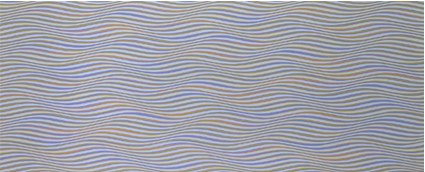Bridget Riley at the National Gallery.
Bridget Riley may be an op art pioneer, but she remains throughtly in tune with the past.
“Bridget Riley: Paintings and Related Work”, a free exhibition in the National Gallery’s Sunley Room, is an invitation to plot multiple pathways from past to present. The show charts developments within Riley’s own career as a painter, which now spans some fifty years and more; and by including works from the National Gallery’s collection it also teases out some of the ways in which she has, throughout that time, drawn on the art of the Old Masters for example and for inspiration.
The National Gallery has been a second home of sorts to Riley ever since her student days, when she painted the careful copy of Jan Van Eyck’s Man With a Red Turban that hangs at the start of the present exhibition. The intended effect is that of a double-take. At a distance, the viewer might be fooled into taking it for Van Eyck’s original, but on closer inspection Riley’s own hand and sensibility come sharply into focus. There is a restlessness in the eyes, and a certain exuberant abstraction in the handling of that red drapery: an early prototype for Riley’s later method, colour and linear structure set adrift from the requirements of precise description.
On the other side of the gallery the artist has contrived a rather different collision of ancient and modern. One of the National Gallery’s pictures, Mantegna’s horizontal grisaille, The Introduction of the Cult of the Cybele, hangs opposite her own shimmering, wave-like Arrest 3, of 1965. The juxtaposition amounts to a picture-puzzle. What on earth might a Mantegna have in common with a shapeshifting geometrical abstraction – a classic of Op Art, as it came to be known – painted...


